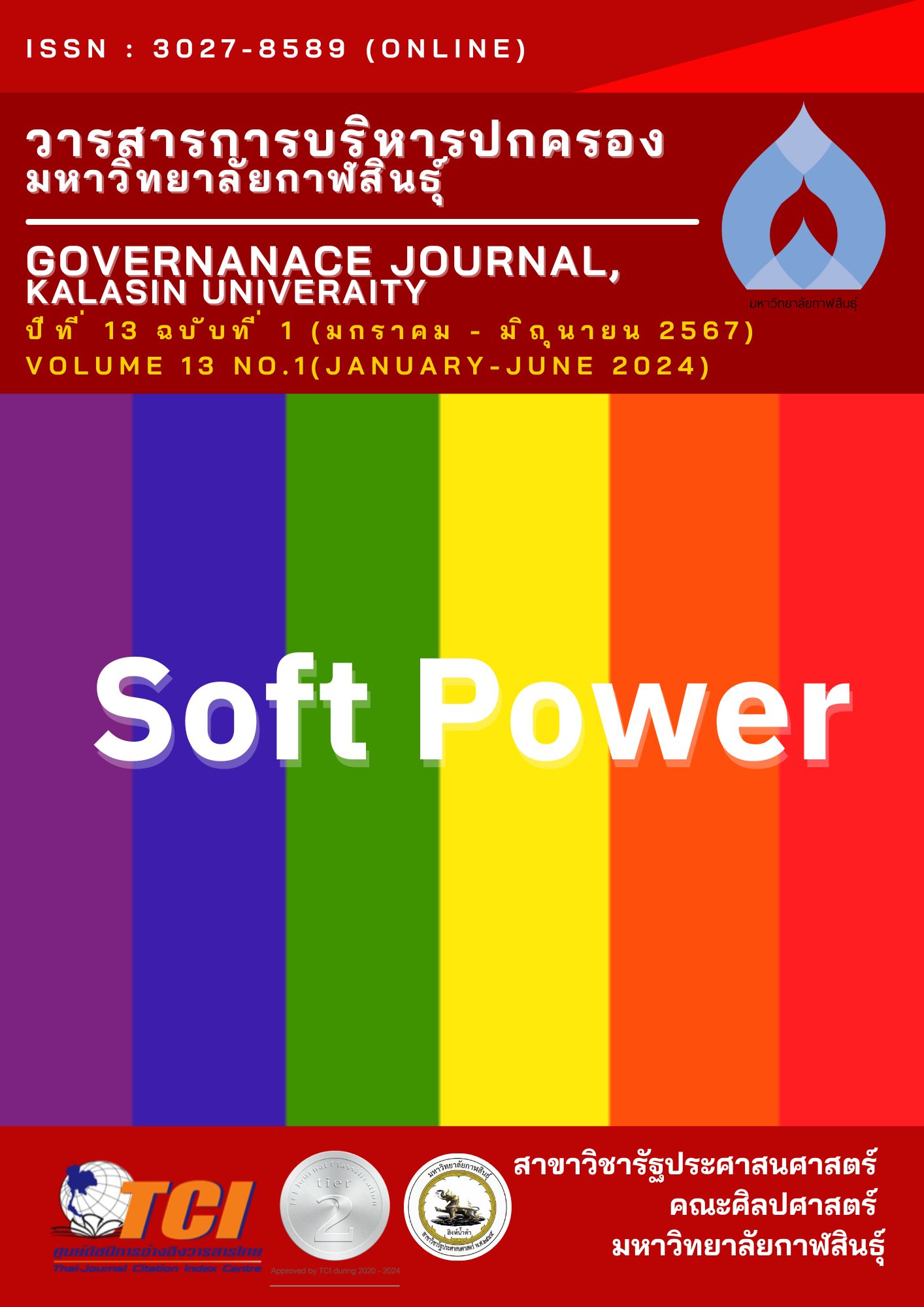แนวทางการบริหารจัดการทรัพยากรน้ำระดับท้องถิ่นเพื่อรองรับ การเปลี่ยนแปลงสภาพภูมิอากาศ : กรณีศึกษาลุ่มน้ำลำตะคอง
DOI:
https://doi.org/10.14456/gjl.2024.5คำสำคัญ:
การเปลี่ยนแปลงสภาพภูมิอากาศ; ท้องถิ่น; การบริหารจัดการทรัพยากรน้ำ; ลุ่มน้ำลำตะคองบทคัดย่อ
การศึกษาครั้งนี้มีวัตถุประสงค์ เสนอแนวทางการบริหารจัดการทรัพยากรน้ำระดับท้องถิ่น เพื่อรองรับการเปลี่ยนแปลงสภาพภูมิอากาศ: กรณีศึกษาลุ่มน้ำลำตะคอง ใช้การวิจัยเชิงคุณภาพ พื้นที่ในการวิจัยกำหนดเกณฑ์ตามความอุดมสมบูรณ์ของทรัพยากรน้ำโดยแบ่งเป็น 3 ระดับ ได้แก่ มีความอุดมสมบูรณ์มาก ปานกลาง และน้อย เก็บข้อมูลด้วยเทคนิคการสัมภาษณ์กลุ่มและการสัมภาษณ์เชิงลึก ตามแนวทางการสัมภาษณ์แบบกึ่งโครงสร้างกับผู้ให้ข้อมูลสำคัญ (Key Informants) ได้แก่ ผู้นำชุมชน ปราชญ์ชาวบ้าน ผู้อาวุโสในชุมชน จำนวน 30 คน และบุคลากรขององค์กรปกครองส่วนท้องถิ่นที่มีหน้าที่เกี่ยวข้องในการบริหารจัดการทรัพยากรน้ำ ร่วมกับการสังเกตแบบมีส่วนร่วมและไม่มีส่วนร่วม ระหว่างเดือนกรกฎาคม พ.ศ. 2562 ถึงเดือนเมษายน พ.ศ. 2563 วิเคราะห์และนำเสนอข้อมูลโดยการพรรณนาวิเคราะห์ (Descriptive Analysis) ผลการวิจัยพบว่า แนวทางการบริหารจัดการทรัพยากรน้ำระดับท้องถิ่น ประกอบด้วย การใช้ประโยชน์ทรัพยากรน้ำ การอนุรักษ์ทรัพยากรน้ำ การฟื้นฟูทรัพยากรน้ำ การกำกับดูแลและการควบคุมทรัพยากรน้ำ การมีส่วนร่วมของประชาชนในการบริหารจัดการทรัพยากรน้ำ และการเพิ่มประสิทธิภาพในการบริหารจัดการทรัพยากรน้ำ
Downloads
เอกสารอ้างอิง
ภาษาไทย
กรมชลประทาน. (2561). ชั้นข้อมูลระบบสารสนเทศภูมิศาสตร์ปริมาณน้ำท่าและปริมาณน้ำฝนในพื้นที่ลุ่มน้ำ
ลำตะคอง. กรุงเทพฯ: กระทรวงเกษตรและสหกรณ์.
กรมป้องกันและบรรเทาสาธารณภัย. (2557). การลดความเสี่ยงจากภัยพิบัติสู่การพัฒนาที่ยั่งยืน. กรุงเทพ ฯ :
สำนักงานโครงการพัฒนาแห่งสหประชาชาติ สำนักงานประเทศไทย.
ชรินรัตน์ บัวพรรษา. (2556). ทรัพยากรธรรมชาติ. สืบค้นเมื่อ 20 พฤศจิกายน 2561, จาก http://charnrat1092838.blogspot.com/2013/08/
พรวิวาห์ กึกก้อง. (2560). จัดการทรัพยากรและสิ่งแวดล้อม. สืบค้นเมื่อ 20 พฤศจิกายน 2561, จาก https://sites.google.com/site/resourcemanagemen00/naew-khwam-khid-laea-hlak-kar-ni-kar-cadkar-thraphyakrthrrmchati-laea-sing-waedlxm
สำนักงานทรัพยากรน้ำภาค 5. (2553). ยุทธศาสตร์การบริหารจัดการทรัพยากรน้ำและลุ่มน้ำลำตะคองแบบ
บูรณาการ. [นครราชสีมา]:สำนักงาน.
สํานักงานนโยบายและแผนทรัพยากรธรรมชาติและสิ่งแวดล้อม. (2558). แผนแม่บทรองรับการเปลี่ยนแปลง
สภาพภูมิอากาศ พ.ศ. 2558 – 2593. สืบค้นเมื่อ 19 พฤศจิกายน 2561, จาก www.deqp.go.th.
ภาษาอังกฤษ
Castelletti, A., Pianosi, F., & Soncini-Sessa, R. (2012). Stochastic and Robust Control of Water
Resource Systems: Concepts, Methods and Applications. System Identification,
Environmental Modelling, and Control System Design. 383-40. Retrieved from
https://link.springer.com/chapter/10.1007/978-0-85729-974-1_19
Chartzoulakis. K., & Bertaki. M. (2015). Sustainable Water Management in Agriculture under
Climate Change. Agriculture and Agricultural Science Procedia Volume 4, 2015,
Pages 88-98.
Dolnicar, S., Hurlimann, A., & Grün, B. (2012). Water conservation behavior in Australia.
Journal of Environmental Management. 105, 44-52. Retrieved from
https://www.sciencedirect.com/science/article/pii/S0301479712001612
Dutta, V., Srivastava, R. K., Yunus, M., Ahmed, S., Vinayak Vandan Pathak, V. V., Alok Rai, A., &
Prasad, N. (2011). RestorationPlan of Gomti River with Designated Best Use
Classification of Surface Water Quality based on River Expedition, Monitoring and
Quality Assessment. Earth Science India. 4(3), 80-104. Retrieved from
https://d1wqtxts1xzle7.cloudfront.net/31017136/
Figueiredo, P., & Perkins, E. P. (2013). Women and water management in times of climate
change: participatory and inclusive processes. Journal of Cleaner Production.
, 188-194. Retrieved from
https://www.sciencedirect.com/science/article/abs/pii/S0959652612001011
Kharrazi, A., Akiyama, T., Yadong, Y., & Li e, J. (2016). Evaluating the evolution of the Heihe
River basin using the ecological network analysis: Efficiency, resilience, and
implications for water resource management policy. Science of The Total
Environment. 572, 688-696. Retrieved from
https://www.sciencedirect.com/science/article/abs/pii/S0048969716313997?via%3Di
hub
Luna, T., Ribau, J., Figueiredo, D., & Alves, R. (2019). Improving energy efficiency in water supply
systems with pump scheduling optimization. Journal of Cleaner Production. 213,
-356.
Mawdsley, J. R., O’ Malley, R., & Ojima, D. (2009). A Review of Climate‐Change Adaptation
Strategies for Wildlife Management and Biodiversity Conservation. Conservation
Biology. 23(5), 1080-1089. Retrieved from
https://conbio.onlinelibrary.wiley.com/doi/full/10.1111/j.1523-1739.2009.01264
Priscoli, D. J. (2004). What is Public Participation in Water Resources Management and Why is
it Important? Water International. 29(2), 221-227. Retrieved from
https://www.tandfonline.com/doi/citedby/10.1080/02508060408691771?scroll=top&needAccess=true
Soudi, M., Ahmadi, H., Yasi, M., & Hamid, A. S. (2017). Sustainable restoration of the Urmia
Lake: History, threats, opportunities and challenges. European Water. 60: 341-347.
Retrieved from http://www.ewra.net/ew/pdf/EW_2017_60_47.pdf
Stakhiv. Z. E. (2011). Pragmatic Approaches for Water Management under Climate Change
Uncertainty. Journal of the American Water Resource Association.
Vol. 47, No. 6, Pages 1183-1196.
UNDP. (2023). The Climate Dictionary: An everyday guide to climate change. Retrieved from
https://climatepromise.undp.org/news-and-stories/climate-dictionary-everyday-guide-climate-change
Woltjer, J., & Niels Al. (2007). Integrating Water Management and Spatial Planning. Journal of
the American Planning Association. 73(2), 211-222. Retrieved from
https://www.tandfonline.com/doi/abs/10.1080/01944360708976154
Translated References
Buapansa, C. (2013). Natural resources. Retrieved from http://charnrat1092838.blogspot.com/2013/08/.
Department of Disaster Prevention and Mitigation. (2014). Reduction Disaster risk to
sustainable development. Bangkok : United Nations Development Programme.
Thailand office.
Kukkong, P. (2017). Management of resources and environment. Retrieved from,
https://sites.google.com/site/resourcemanagemen00/naew-khwam-khid-laea-hlak-
kar-ni-kar-cadkar-thraphyakrthrrmchati-laea-sing-waedlxm.
Office of Natural Resources and Environmental Policy and Planning. (2015). Master plan
supports Climate change 2015 –2593. Retrieved from, www.deqp.go.th.
Royal Irrigation Department. (2018). Geographic information system data layer for
runoff and rainfall in the Lam Takhong Basin area. Bangkok: Ministry of Agriculture
and Cooperatives.
Water Resources Office Region 5. (2010). Management strategy. Integrated water resources
and Lam Takhong Basin. [Nakhon Ratchasima]: office.
ดาวน์โหลด
เผยแพร่แล้ว
รูปแบบการอ้างอิง
ฉบับ
ประเภทบทความ
สัญญาอนุญาต
ลิขสิทธิ์ (c) 2024 วารสารการบริหารปกครอง มหาวิทยาลัยกาฬสินธุ์

อนุญาตภายใต้เงื่อนไข Creative Commons Attribution-NonCommercial-NoDerivatives 4.0 International License.








